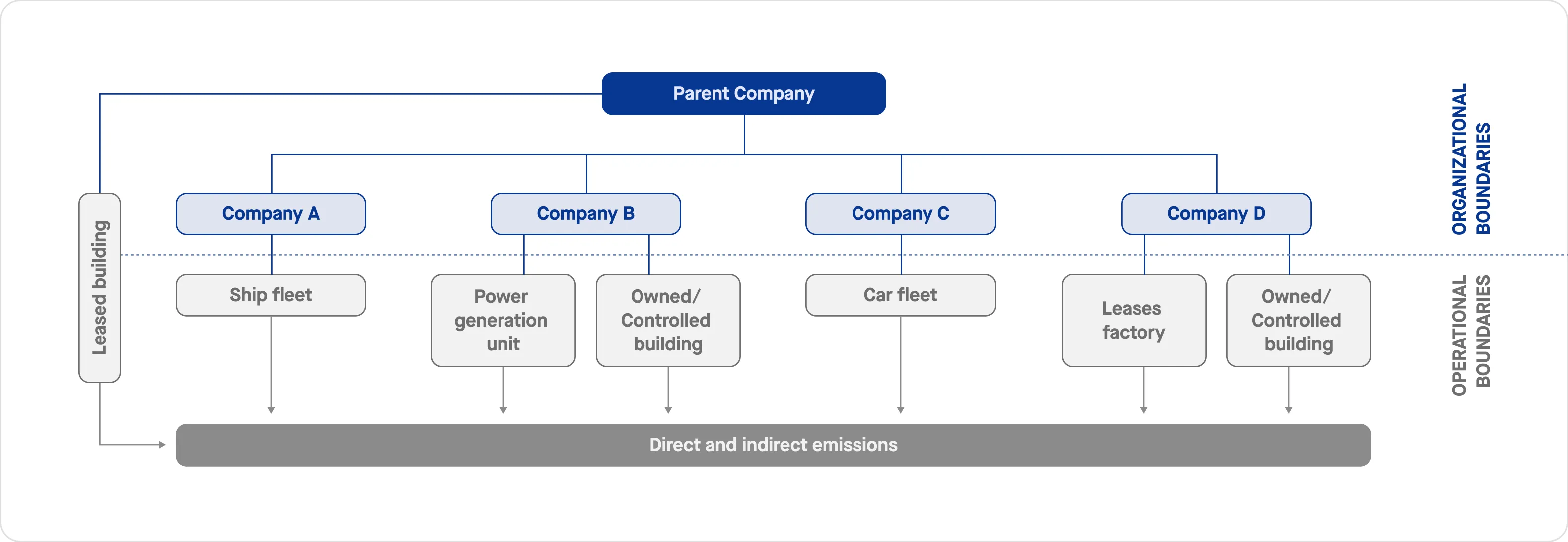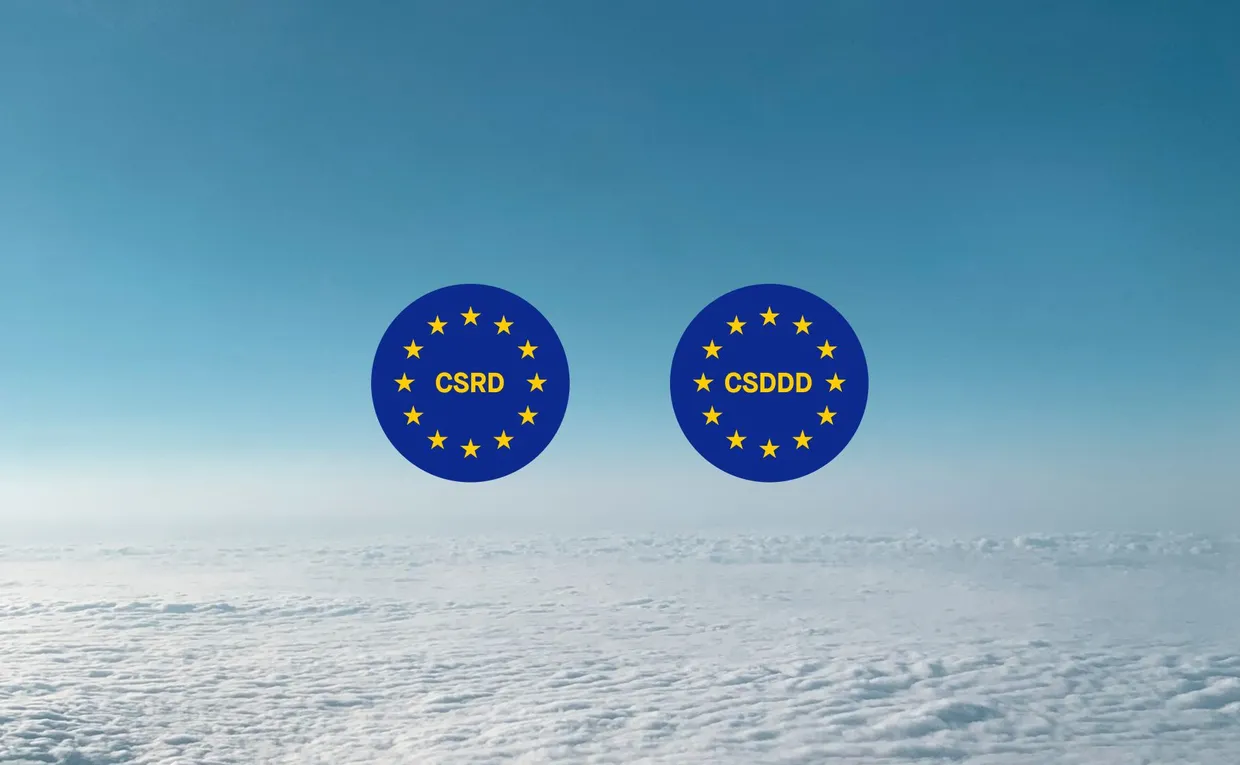Ready to start measuring your company’s carbon footprint? Before you do so, you’ll need to set your Greenhouse Gas (GHG) inventory boundaries and a baseline for reporting. Below, we outline how to measure your baseline year, the methods of establishing your organizational and operational boundaries, and how to deal with any changes that occur to these boundaries.
What does a GHG inventory consist of?
A GHG inventory consists of four parts.
1. Scoping
First, you’ll have to agree on scoping. This means you have to think about your intended user. Setting up a GHG inventory requires making choices, for example on reporting and organizational boundaries. These choices affect the information value for the readers of your GHG report.
2. Quality checking
Second, you have to set up a system for checking the quality of the GHG inventory system. This includes your approach for collecting documentation for the measurements and emission factors that you use. This makes your GHG inventory “auditable”. You’ll also have to check the quality of your data periodically (“controls”). Finally, l document how your GHG inventory works – who does what, when, where, and how (“the procedures”). This includes a base-year review and recalculation policy (explained below).
3. Deciding on GHG emissions factors
Third, once you start measuring your activities (“activity data”) you’ll have to select emission factors to calculate your total greenhouse gas emissions. These have then to be allocated to an emission category (“scope”) and to a reporting entity. Once you have sufficient data for a reporting period (normally: a year), you can set this as a base-year. Every year, you check whether events occurred that require recalculating your base-year. Such events include changes in organizational scope (e.g. mergers and acquisitions), changes in calculation methodology or emission factors, and (accumulated) errors or omissions.
4. Building your GHG report
This is a report that describes your organization’s GHG-related activities to your investors, employees, and any stakeholder keeping track of your carbon footprint. Required information includes background of your organization, the reporting period covered, GHG emissions and GHG reductions, and changes which occurred since the last reporting period.
In this blog post, we discuss setting the scope of your GHG inventory (step 1).
How do you set the scope of your GHG?
Intended users of your GHG inventory
First, you will have to think about the intended users of your GHG inventory. Your organization and the legal environment in which you operate can set specific requirements. For example, the European Commission (EC) is introducing a mandatory Environment, Social, and Governance (ESG) reporting framework in its Corporate Sustainability Reporting Directive (CSRD). The EC is developing sustainability standards which affect the requirements for your GHG inventory. Another emerging standard is the International Sustainability Standard Board (ISSB) reporting framework for climate-related disclosures.
Setting organizational boundaries
In this step, you identify emission sources for which you will collect data – including both direct and indirect emissions. You will have to categorize these sources into three groups.
-
First, there are emission sources that are part of your organization, for example your vehicle fleet, offices, warehouses, factories, countries and sites. These emission sources are responsible for your direct GHG emissions (Scope 1).
-
Second, there are emissions which can be attributed to the energy which is consumed by you. This includes electricity, heat, steam, and cooling (Scope 2).
-
Third, you have to identify all emission sources in your value chain. This includes emissions from your suppliers and from clients using your products or services (Scope 3). The emissions from Scope 2 and 3 constitute your indirect GHG emissions.
From this description you can see that setting identifying Scope 1 emission sources automatically defines the Scope 2 and Scope 3 categories. There are two main approaches to this. First, you can find out to what extent your company owns other entities: the equity approach. Second, you can list the entities over which you have financial or operational control. The difference between operational control and financial control is shown below.
-
Operational control: “A company has operational control over an operation if it or one of its subsidiaries has the full authority to introduce and implement its operating policies at the operation.” (Source: GHG Protocol Corporate Standard)
-
Financial control: “The company has financial control over the operation if the former has the ability to direct the financial and operating policies of the latter with a view to gaining economic benefits from its activities.” (Source: GHG Protocol Corporate Standard)
You can report GHG emissions pro rata if you apply the equity share approach. That is, if you own 30% of the shares then you report 30% of the emissions. When you apply a control approach (financial or operational) you can report 100% of the emissions in most cases.
Emerging ESG reporting frameworks require that emissions from consolidated and unconsolidated company assets are reported separately. Consolidated assets appear in your financial statements, whereas unconsolidated (e.g. joint ventures, unconsolidated subsidiaries, associates) assets don’t. The CSRD requires that consolidated assets are reported following the financial control approach, and unconsolidated assets following the operational control approach. The climate standard from ISSB is more flexible, but nevertheless requires separate reporting.

Source: GHG Protocol, 2004
Setting operational boundaries
“Operational boundaries” refer to the classification of emission sources according to Scope 1, 2, and 3. As described above, setting organizational boundaries does this by definition. However, further nuances can be made for Scope 2 and 3 emissions.
First, the GHG Protocol introduced the concept of “location-based” and “market-based” Scope 2 emissions in 2015. “Location-based” means that you consider scope 2 GHG emissions as physically provided to you. For electricity, this means that the kg CO2/kWh reflects the regional or national average of the grid emissions intensity. However, companies can and do purchase green electricity and renewable energy certificates.This isn’t directly reflected in location-based emissions, hence the introduction of market-based emissions. Reporting Scope 2 emissions is required when you apply the GHG Protocol or the CSRD ESRS E1 standard. The ISSB S2 standard doesn’t mention separate Scope 2 categories.
Second, the GHG Protocol defines Scope 3 emissions as a voluntary reporting category in its revised (2004) version. Later on, a Scope 3 standard (2011) and guidance (2013) were issued. The Scope 3 standard defines 15 GHG emission categories which may or may not be relevant for your organization. Setting operational boundaries thus requires an evaluation of which categories are most relevant for your operations. You can find the Scope 3 categories which are likely to be important for your sector in CDP guidance and in the standards developed by the Sustainability Accounting Standards Board (SASB). Emerging standards are now emphasizing the importance of calculating GHG emissions across your entire value chain – meaning that the reporting of Scope 3 emissions is no longer voluntary. Note however that only relevant Scope 3 categories need to be reported. It isn’t necessary to report all 15 categories.
How do you set and update a base year?
You can set a base year once you have complete and verifiable data for a reporting period. Typically, this base year is recent and representative. “Representative” means that the GHG emissions are typical for normal operations. A non-representative year occurs, for example, when your operations are reduced because of downtime or reduced demand because of the recent Covid pandemic. You measure emission reductions and reduction targets vis-a-vis this base-year.
There are three conditions that may require the revision of your base-line year emissions:
-
If you’ve discovered errors.
-
If the calculation methodology has changed (e.g. a change in emission factors or global warming potentials).
-
If your organizational boundaries may have changed (e.g. through mergers and acquisitions).
The GHG Protocol requires that each organization develops a base-year review and recalculation policy. Here, you define how you review the base-year for the changes listed above, at which threshold base-year recalculation is triggered, and how you update and document the new base-year.
Some of the conditions under which you should or shouldn’t recalculate your base-year are listed in the GHG Protocol, and are listed below. You can extend these criteria and make them more explicit in your base-year review and recalculation policy.
| Situation | Baseline year recalculation required? |
| You’ve bought an organization, or merged with one | Yes |
| As above, but the company you’ve bought or merged with didn’t exist in the baseline year. | Yes, but calculation can’t go back to the baseline year |
| You’re outsourcing or insourcing and closing/opening new sites. | No recalculation required if the emissions are reported in Scope 2 or Scope 3. |
| You’ve opened or closed sites that were already controlled or owned by your company. | No recalculation required. |
| You’ve increased/decreased production, or changed the product mix. | No recalculation required. |
| You’ve opened a new site that was not controlled or owned by your company previously (or was newly built). | Yes |
Note that a base year recalculation may be required not just for organizational change, but also for errors, or changes in calculation methodology.
How can Sweep help?
New regulations require you to report more climate-related indicators than ever before. You also have to slide and dice these indicators over more dimensions, e.g. over consolidated and unconsolidated company assets. All this means that a GHG inventory can no longer be efficiently measured using an Excel spreadsheet.
Sweep offers you efficient and transparent management of GHG data, no matter the size of your organization. And we continuously add new features which ensure that we’re complying with the latest regulations.
Find out more about how we can help you get started with your GHG inventory.



